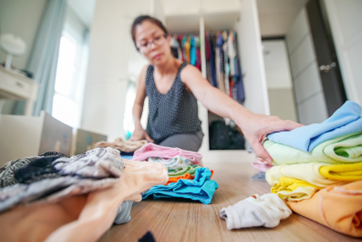By Sarah Davey
If you can’t lay your hands-on items quickly because they’re buried under piles of junk; if you’re constantly ‘stuff-shifting’ – moving things from one pile to a new ‘temporary’ pile; if you find yourself thinking, “I can’t throw this away, it might come in useful one day,” you’re probably a clutter victim.
One of the side-effects of the events of 2020 was that many of us had more time and less money. We embraced a simpler, slower, less covetous lifestyle and many of us feel we’d like to keep something of that as we move towards a post-pandemic world. There was a collective realisation that possessions are less important than the people we missed.
A decade ago, Californian blogger Dave Bruno set himself the year-long experimental task of reducing his belongings to just 100 items. When his experiment concluded he found he wanted to keep living by his new rules, preferring simplicity to consumerism. His book is worth seeking out.
Since then, whole movement has developed around the aim of a simpler, more minimalistic lifestyle. There are some great blogs and podcasts available: The Practical Minimalists, and The Minimalists are two worth listening to. Listen to them for inspiration while you declutter. I’m not recommending a sparse monastic lifestyle, but most of us put far too much time, effort, and money into acquiring, keeping, and storing possessions. Sometimes it’s good to let go.
If you’re ready to de-clutter, then we have a few simple tips. If you feel you need help, there are experts in de-cluttering who will guide you through the process of letting go.
Deal with one room at a time The task will seem less daunting. Stick with that room until it’s finished.
Choose a nice day Take the room con-tents outside. Psychologically it’s easier to sort and let go if you’re one step removed. It’s also less likely that the clutter will make it back inside.
Sort everything into three piles Label them dump, donate, and keep. Be realis-tic: if the item in question hasn’t been used for over a year it is unlikely you will ever use it.
Deal with the dump and donate piles Do this before anything comes back into the house. It’s much harder to mess up your good work if the stuff is physically gone.
Sort and label Place the remaining items in clearly labelled boxes. Make sure there is one temporary box to house items which really belong in another room. As each room is sorted those items can be replaced, and other misplaced items can be housed there while the de-cluttering process continues.
Replace everything that remains The maxim ‘A place for everything and every-thing in its place’ is a good one. House small items in clear plastic boxes and store them in cupboards or wardrobes.
Now you’re done instigate a one thing in: one thing out rule. It will make you think twice about acquiring something if you know something else has to go.
Finally, once a week, take two bags and go through your home. One bag is for rubbish, the other for items in the wrong place. When you’ve finished throw the rubbish away and replace the misplaced items.

